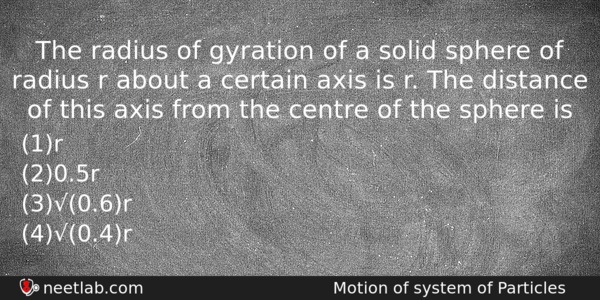| ⇦ | 
| ⇨ |
The radius of gyration of a solid sphere of radius r about a certain axis is r. The distance of this axis from the centre of the sphere is
Options
(a) r
(b) 0.5r
(c) √(0.6)r
(d) √(0.4)r
Correct Answer:
√(0.6)r
Explanation:
No explanation available. Be the first to write the explanation for this question by commenting below.
Related Questions: - A circuit area 0.01 m² is kept inside a magnetic field which is normal to its plane.
- When a bullet of mass 10 g and speed 100 ms⁻¹ penetrates up to distance 1 cm
- A train of mass 2x 10⁵ kg has a constant speed of 20 m/s up a hill inclined
- The threshold frequency for a photosensitive metal is 3.3 x 10¹⁴ Hz.
- Two small spherical shells A and B are given positive charges of 9C and 4C
Topics: Motion of system of Particles and Rigid Body
(73)
Subject: Physics
(2479)
Important MCQs Based on Medical Entrance Examinations To Improve Your NEET Score
- A circuit area 0.01 m² is kept inside a magnetic field which is normal to its plane.
- When a bullet of mass 10 g and speed 100 ms⁻¹ penetrates up to distance 1 cm
- A train of mass 2x 10⁵ kg has a constant speed of 20 m/s up a hill inclined
- The threshold frequency for a photosensitive metal is 3.3 x 10¹⁴ Hz.
- Two small spherical shells A and B are given positive charges of 9C and 4C
Topics: Motion of system of Particles and Rigid Body (73)
Subject: Physics (2479)
Important MCQs Based on Medical Entrance Examinations To Improve Your NEET Score
18000+ students are using NEETLab to improve their score. What about you?
Solve Previous Year MCQs, Mock Tests, Topicwise Practice Tests, Identify Weak Topics, Formula Flash cards and much more is available in NEETLab Android App to improve your NEET score.
Share this page with your friends

Using parallel axis theorem ,
I =Icm(about the centre of mass) + M(mass of the sphere)h2. where h is the required distance of the axis from centre of sphere
MK2 = 2/5 MR2. + Mh2
K2= 2R2/5 + h2
R2 = 2R2/5. + h2. (given that. K=R. )
3R2/5 = h2
Which gives h=√3/5R2
h=√0.6. R. (Answer)